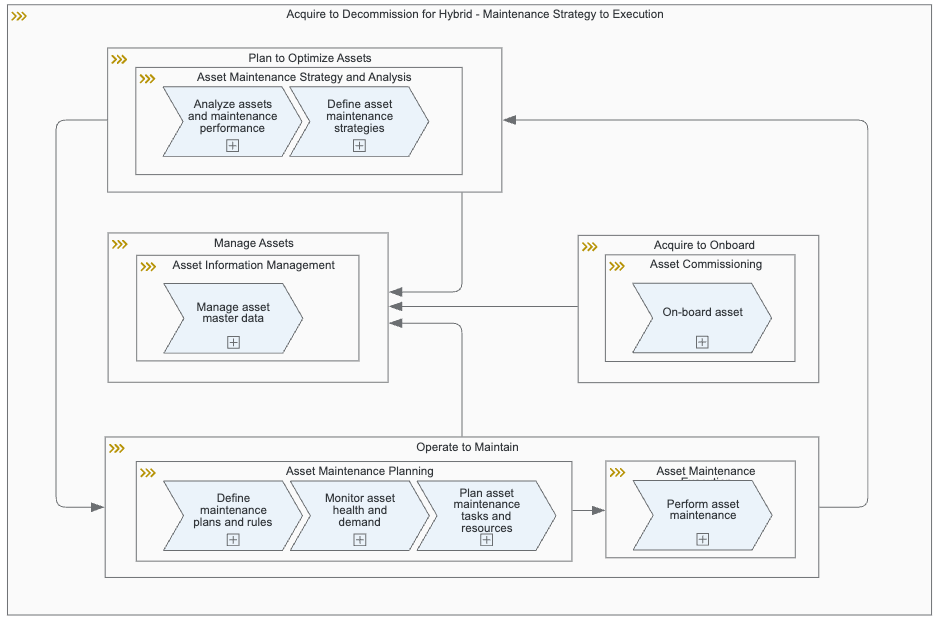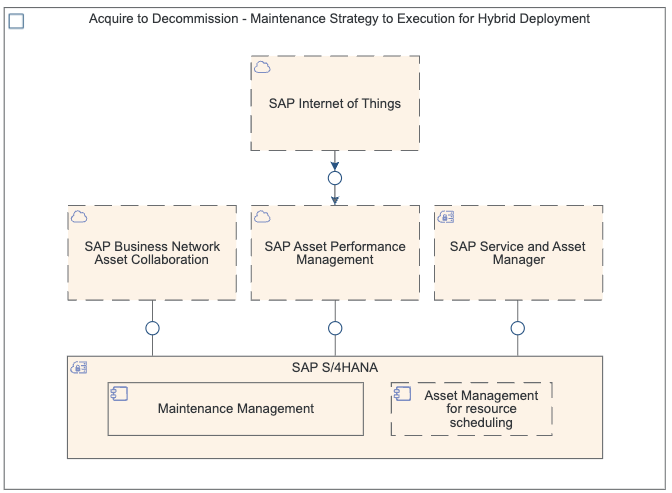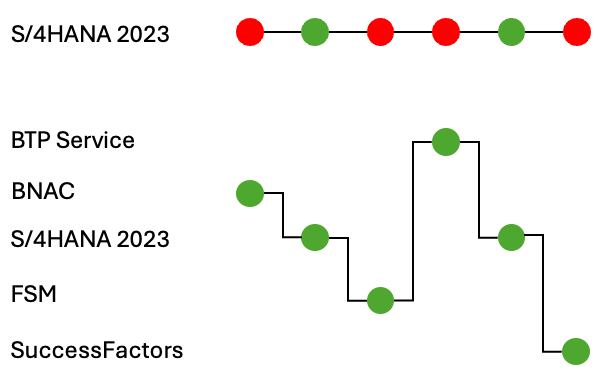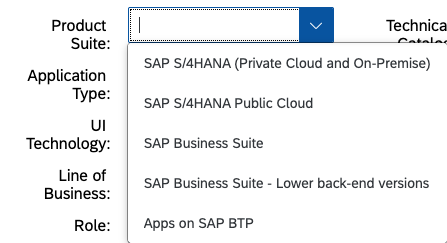Fiori Readiness
Definition
Fiori Readiness indicates if a process can be executed using exclusively Fiori apps.
The Fiori Readiness factor is for a given process, not for a whole system.
Examples:
- All tasks in a process in an SAP system that require human interaction can be executed using a Fiori app. In that case, the Fiori Readiness is 100%.
- In case that for half the tasks are executed using a non-Fiori app like (Web) Dynpro based applications, the Fiori Readiness is 50%.
The Fiori Readiness serves several purposes. One important is expectation management. Another one is to identify gaps in the Fiori strategy. It provides input regarding the business processes and IT architecture roadmap. For calculating the Fiori Readiness, several dimensions need to be taken into consideration. There are the SAP standard processes as well as customer processes, with the ERP release and SaaS solutions on top as an additional dimension.
SAP
One way to calculate the Fiori Readiness is to look at a standard process from SAP. How far can you go with Fiori within such a standard SAP process? The SAP release is the main determining factor of the Fiori Readiness. You cannot expect a value of 100% for a process running on SAP ECC 6 EHP8, nor for older S/4HANA releases. Having a process fully executable on Fiori is also for SAP a journey. For newer releases, like 2023, the Fiori Readiness can be 100%. Looking at the Fiori Readiness of a process, starting from older releases to e.g. S/4HANA 2023, the missing Fiori apps (red dots) should turn green; indicating that a Fiori app is available.

Depending on the process, the Fiori Readiness can differ. The graphic below shows as an example Processes A, B and C. Process A and C have a Fiori Readiness of 100% since S/4HANA 2022 (and Process C since 2021), Process B is still not there. On recent S/4HANA releases, Fiori Readiness should be 100%, but you cannot expect this. While the expectation might be to say that for a recent S/4HANA system the Fiori Readiness should be 100%, you must add Cloud ERP into consideration.

Using S/4HANA you might “only” get 80% Fiori Readiness. Using the cloud products from SAP, you can get to 100%. Maybe only a few apps you are using in your process were made available as Fiori in S/4HANA? Maybe the future of the product is in the cloud, therefore investment is happening there and to get the full Fiori experience, you need to go to the cloud. For instance, take EAM.

The overview page already shows clearly: it’s not one single product. Take as an example the process Acquire to Decommission.

In the component view it gets clear that there is more than just one single S/4HANA system involved. S/4HANA is extended by several cloud products like BNAC, APM, SAM.

After all, SAP is investing mostly into cloud products. Some features might be available in S/4HANA; but deprecated. Maybe the successor to apps and processes is now in the cloud. This can result in a process where only a few Fiori apps are available in S/4HANA. The successor to a transaction might now be offered in the cloud. SAP might not have removed the old transaction, and the process continues to work in an S/4HANA system. Running the process in an S/4HANA system alone might result in having to use deprecated apps or having to deal with gaps. The Fiori Readiness for such a process in S/4HANA 2023 might look like this:

How to get a 100% Fiori Readiness for such a process? The implications for customers are simple: use cloud products. To get 100% Fiori Readiness, means to adopt cloud solutions. Biggest problem here is SAP’s communication. It is way harder than you expect to find this kind of information. Starting from the process and the apps involved: is this still the way to go? Do I need to adopt the cloud offering? What when SAP offers a Fiori app as a transaction replacement, but that app is now also being replaced by a new – cloud – version? Starting the journey today, how will the situation be in 2+ years? Unfortunately, the Fiori Apps Library won’t show this information super easy. You need to go to the SAP roadmap, analyze the portfolio or the current business processes and components involved. As a result, customers can get the insights needed to get a Fiori Readiness of 100%. If this means to use 5 different SAP products, than that’s the price to pay.

Customer
The customer layer is adding several dimensions. While there is an SAP standard process, there can be as many – or more – custom processes as there are customers. The Fiori Readiness for every customer, even when using the same process, will differ. A process might be realized with a mix of standard transactions as well as Z-apps, or even non-SAP systems. In some cases, Web Dynpro is in place, others already adopted an SAP Fiori app or developed their own. The wide range of possible starting points makes it complicated for customers to achieve 100% Fiori Readiness.
An important task is to define whether to go for SAP standard. Adoption SAP standard is like described above. Several cloud products might be needed. This comes with some impact on the current processes and architecture. Adopting a pure greenfield approach will result in a high Fiori Readiness. However, this might also not be doable for core processes that include customer individual adjustments. For non-core processes like e.g. HCM, this is an option. Nice side effect: processes are identified as non-core and brought back to standard. Releasing resources to focus on more important tasks for the company. Adopting SAP standard is not an easy task and will take time.
When SAP standard is not an option, achieving 100% Fiori Readiness means additional work. It comes with change management, a new target architecture and development work. Starting from ECC, the Fiori Readiness for customers will be very low. Using a brownfield / avocadofield approach, the Fiori Readiness might increase, but do not expect a high value. For instance, if a process currently involves a SAP transaction (IQS1/IW21/…), and this transaction is available in S/4HANA, it can (and will) be used. However, a Fiori app is available to create maintenance requests. This app must be integrated into the process, so users start using it. This involves change management.
Specially the custom developed apps are a challenge. In the graphic below a process in ECC 6 EhP8 has 4 custom developed apps, one Fiori app (green) and one standard transaction (red). While the one transaction can be transformed to Fiori in S/4HANA 2023, this is not true for the custom apps. These are either not covered 1:1 by SAP or there is no easy replacement available.

A challenge is to know what to do with these apps. Can these be replaced by standard apps? Can a standard app be customized to serve as a replacement? Are they really needed or only nice to have apps? How to bring those to Fiori? Redevelop? Maybe first start with Personas? In case custom apps from a process must be developed from scratch to be Fiori apps: does the outcome justify the effort? This should only be the case if the apps are a differentiator. If they are what makes the process unique.
To solve this challenge, the process must be known. Is there a standard process available? Where and why does the custom process differ? The Fiori apps available that match the custom process must be known. And where they are available. And how they can be adopted to custom needs. Once for the replacement apps (ECC -> S/4), as well as the apps for the cloud solutions. The later is important to know if an app – and therefore the related process – is moving to the cloud or not. For this to work, the Fiori App Library must include the Fiori Apps that are available in SAP’s cloud solutions. SuccessFactors, SAP Cloud PLM, ARIBA, etc. offer Fiori like apps. The backend might not be ABAP or CAP based; OData might not be used. But if the app follows the Fiori design guidelines, why care too much about the technical implementation. It’s a Fiori app and that’s what counts for the Fiori Readiness calculation. It must work for the end user. The Fiori Readiness is not about UI5 based apps. It is covering apps that are following the Fiori Design Guidelines.
One problem of the SAP Fiori Apps Reference Library is that is lists the Fiori Apps for S/4HANA and the Business Suite.

While finding out the future of a process is a task for functional consultants, it is naïve to think that they are constantly studying the SAP roadmap. Too often the list of current transaction codes is entered, and the corresponding Fiori apps are taken as input for the new process on S/4HANA. It would be nice to see also the (development / investment) status of an app or if the process it is part of is moving to cloud. Rarely Fiori apps are implemented in one day. This is part of a project that might take even years to complete. A side effect of adding more process and roadmap related information to the reference library: its usage would shift from app based to a process-oriented view. After all, companies are using SAP to run their processes. An app is just a means to do this. A process related view could show what apps are missing or moved to another solution and plan accordingly.
Benefits
What is the benefit of knowing the Fiori Readiness? It allows to handle expectations. From the business and from the end users. It shows if after implementing S/4HANA the effort is paying off in being aligned with SAP standard – process and UX – or not. If staying on S/4HANA is sufficient or if additional cloud products are needed. It shows if the effort put into one process results in a Fiori Readiness of 100% or not. And if not, why not. It helps to identify heavily customized processes, ones that are maybe not covered by SAP. It also shows what is needed effort wise to get back on track. And therefore, it helps to rise awareness to keep apps, processes and landscape closer aligned.
Having the Fiori Readiness for all processes shows where investment might be needed. Calculating the Fiori Readiness with a transformation roadmap that goes over several years will reveal which processes are stale. Why does the Fiori Readiness not increase? Why is it shrinking? Those could be processes where it makes sense to move away from SAP. Or to invest and ensure that the process is updated to benefit from the latest SAP innovations. If the investment means to redevelop an app to make it a Fiori app: then the Fiori Readiness can serve as a justification to spend the time and money.
0 Comments